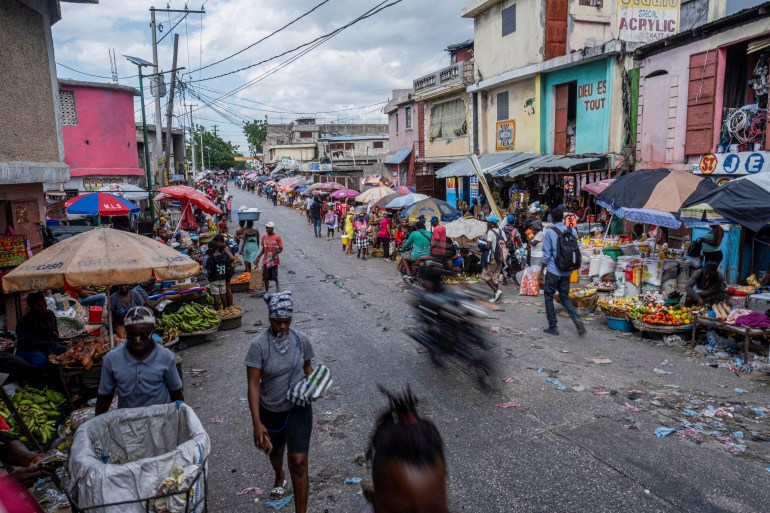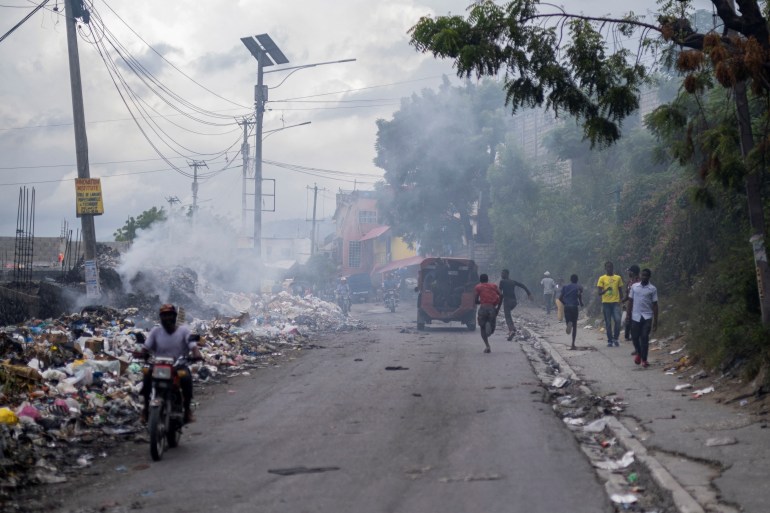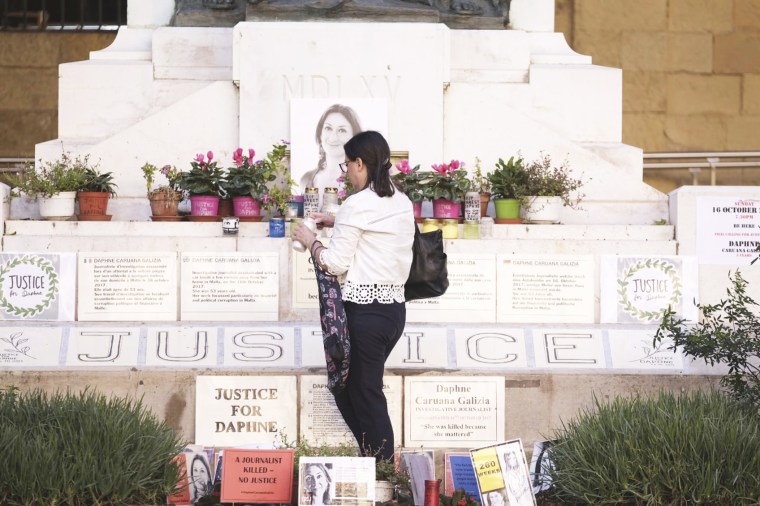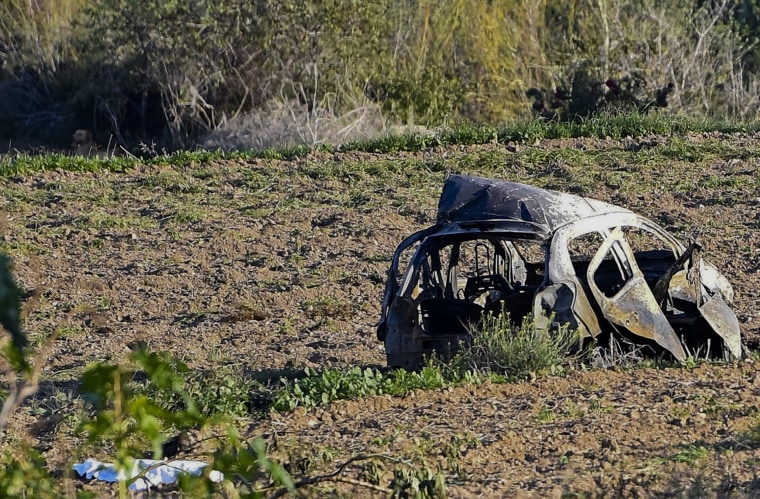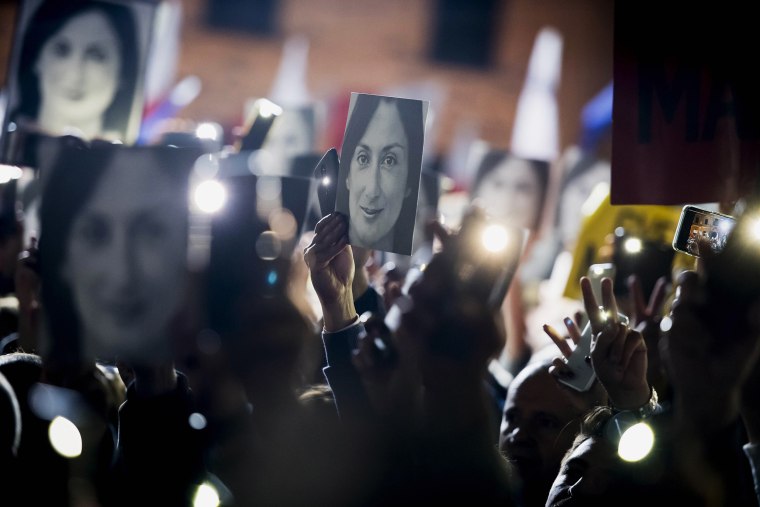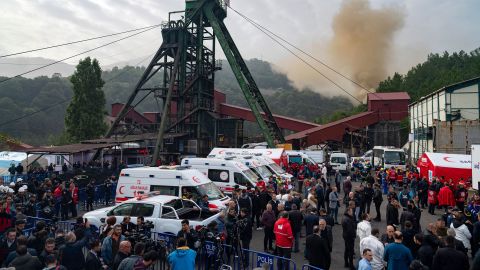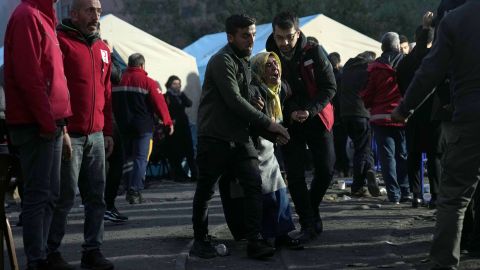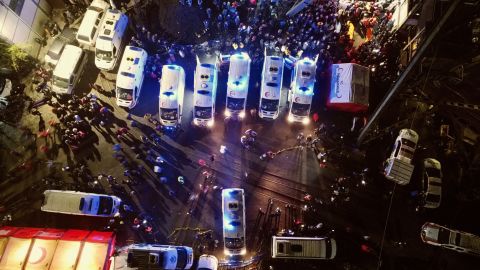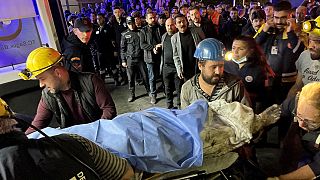By FELICE FRIEDSON/THE MEDIA LINE AND Sara Miller/ The Media Line - Yesterday
For four weeks, the streets of Iran have been ringing with cries of “Women, Life, Freedom” – the slogan of a burgeoning revolution born of a desire for true liberty.

People light a fire during a protest over the death of Mahsa Amini, a woman who died after being arrested by the Islamic republic
Through an internet connection becoming increasingly difficult to access, Iranian protester Vahid tells The Media Line that he and his compatriots are ready to put their lives on the line to crush the dictatorship that has ruled their country for more than four decades.
“We want the whole world to know that we don’t want this regime, and we’re going to fight until the last drop of our blood to get rid of this regime,” he says of the fight against a brutal rule more than ready to use immense force to quell its own population.
His comments are echoed by Jasmin Ramsey, the deputy director of the US-based independent Center for Human Rights in Iran.
“We want the whole world to know that we don’t want this regime, and we’re going to fight until the last drop of our blood to get rid of this regime.”Vahid
“There are so many people in Iran that feel that they live under the thumb of an authoritarian government, and they are risking everything to speak out against that government,” she says.

A police motorcycle burns during a protest over the death of Mahsa Amini, a woman who died after being arrested by the Islamic republic's ''morality police'', in Tehran, Iran September 19, 2022 (credit: WANA (WEST ASIA NEWS AGENCY)
Civil unrest
The civil unrest now being felt across the entire country was ignited following the death of 22-year-old Mahsa Amini in a Tehran hospital on September 16. Her death came three days after she was detained in the capital by the Islamic Republic’s so-called morality police for not wearing the compulsory hijab in a manner they deemed suitable. Amini had been on a visit to Tehran with her family from Saqqez in the Kurdistan Province of Iran.
The government said the young woman suffered a heart attack at the police station, fell into a coma, and died. But according to eyewitnesses, among them other women arrested with her, Amini had been brutally beaten by police.
UK-based Iran International news channel claims to have obtained the CT scans of Amini’s head taken after her death, which it says “vividly show a skull fracture on the right side of her head caused by a severe trauma.”
Her death proved to be the touchpaper for mass protests – led by the women who have borne the brunt of the religious regulations that have dominated the lives of Iranians since the 1979 Islamic revolution toppled the secular government.
“This time around, the women have become the leaders of these actions,” Vahid says. “‘Til now men were, but now women are leaders.”
Amini was just the first young woman to die at the hands of the regime’s security forces in the massive civil unrest that has erupted, with 17-year-old Nika Shakarami and 16-year-old Sarina Esmailzadeh among the scores killed as the government tried to end the swell of opposition that has ignited throughout the country. The Norway-based Iran Human Rights organization says that at least 201 people, including 23 children, have been killed in the crackdown on the rebellion that quickly spread in size and scope.

A man gestures during a protest over the death of Mahsa Amini, a woman who died after being arrested by the Islamic republic's ''morality police'', in Tehran, Iran September 19, 2022. (credit: WANA VIA REUTERS)
On September 30, the Amnesty International human rights organization said it had received leaked documents dated exactly a week earlier, showing that the Iranian military’s top brass ordered its armed forces to “severely confront” all protesters in every part of the country. This included opening fire on demonstrators, using tear gas and water cannons, and restricting internet access in order to hamper efforts to organize protests.
According to Vahid, while the killing of Mahsa Amini was the match that ignited the fire now burning across the country, the inferno was inevitable.
“Mahsa was only a spark, a catalyst,” he says. “People are waiting, and they can take advantage of any spark that can cause them to rise up against the regime. Sooner or later this would have happened. Mahsa was the spark that caused this to happen sooner.”
Crucially for a success that is not guaranteed, the protests have been embraced not only by the people under 40 who make up well over half of the population but now also by older men and sectors of the oil industry once beholden to the regime.
“The oil workers’ strike is a big deal, even though it is only one segment of the oil Industry,” says Dr. Iman Foroutan, the executive director of The New Iran think tank, who also served as translator for Vahid. “The hope is that more and more people will start their strikes.”
Unsurprisingly, many vocal in their support for the protests can be found in the universities of Iran.
“More than 100 universities … have had protests in recent days, and we have the names of at least 116 students who have been arrested,” Ramsey tells The Media Line.
“Professors are also taking great risks by doing this. They have tried to protect the students from being arrested. They are trying to show solidarity, but it’s not enough. What I should say is that if you’re a professor at a national university in Iran, you are going to have a big lynch [sic] on you. They want you to toe the state line, and even before this was happening, even before these protests broke out, professors were being arrested in Iran under this government of [President Ebrahim] Raisi, who is very conservative and wants to take Iran back to the ages of the 1980s when repression was at its peak and freedom was at its lowest.”
Vahid maintains that almost all of those involved in higher education in Iran are joining the protests, with the exception of some who are closely connected to the regime.
“All universities and colleges throughout Iran are on strike,” he says. “Students and a lot of the professors don’t go to classes. … A lot of the professors have joined students talking and demonstrating and not going to classes.
“There are professors who go right now and teach empty classes like [Mohammad Javad] Zarif, who used to be the foreign minister of Iran. He is now a professor in Tehran University. He goes.”
The protests are “interestingly characterized by the emphasis on young people and women,” Ramsey says. “I think that the stat that you have to look at [is] the population. It’s something like 70 or 80 [million people in Iran]. Sixty percent is under the age of 35, and so many young people feel that they don’t have any opportunity, and that is why these young people are really coming out and saying that they want more. They want better.”
Yet for all the support for the protesters’ cause within Iran, Vahid says, the change will be hard-won without pressure on the regime from the rest of the world.
“I have questions for all the countries, except for maybe Israel: Why aren’t they recalling their ambassadors to go home?” he demands.
“[What] all of these other governments have done is that they have had talking points. They are sorry to hear the news, or they feel bad for us, but they have not done any tangible action to help us or support us.”
Ramsey also has a message for the heads of state who have been reluctant to voice their concerns about the actions of the Iranian regime.
“To the world leaders that are not speaking out, I would ask what side of history they want to be on, because what people are really calling out for is fundamental and basic human rights, and how you can be silent in the face of that is just astounding to me,” she says.
In Vahid’s eyes, foreign governments are reluctant to help Iranians bring about real change because they “all benefit from the treasures of Iran.”
“The main reason is because these countries work with the Islamic Republic of Iran, and that is why they do not come out against it or do anything tangible against IRI,” he says.
“Over the years, they have taken from the Iranian people and country all of our assets, all of our treasures, all of our oil and precious minerals and whatever else [they wanted].”
Dr. Avi Melamed, founder of the Inside the Middle East Institute, which provides nonpartisan education on the region, agrees that vital expressions of support from the West have been lackluster.
“There is a need for Western support and external support, and in that sense, not so surprisingly, there is a lot of discontent,” he says. “There is a growing feeling of disappointment [among] both the Iranians and peoples in the region vis-à-vis the position of the West.”
Like Vahid, Melamed believes foreign nations should be recalling their ambassadors from Iran as an initial step but argues a more stringent response is also needed.
“I would expect very tough sanctions on the Iranian regime and its major leaders,” he says. “I would expect some international decisions that will have teeth and will be applied and will be reinforced on the ground to make very clear that the West will not put up with that story, but what we see so far is very mild.
“We see gestures of Western leaders, but what we don’t see is Western leaders or Western influential media [speaking out].”
The European Union this week agreed to sanction the Iranian regime for its brutal response to the protests, although the actual form of those sanctions has yet to be decided.
The Iranian people, Vahid asserts, will remove the Islamic government with or without help from abroad.
“If the foreign countries do something tangible to help us, obviously that will help us to get rid of this regime faster, sooner, and with less casualties. If they don’t, we’ll still continue our fight,” he vows.
Massive intervention could prove tricky for some foreign governments, with US President Joe Biden determined to revive the 2015 agreement that curbed Iran’s nuclear program in return for lifting harsh economic sanctions that crippled the country’s economy. The agreement, officially known as the Joint Comprehensive Plan of Action (JCPOA), effectively fell apart when former US president Donald Trump pulled his country out in 2018 and reimposed strict sanctions.
Yet such geopolitical considerations carry little weight with Iranians who want their freedom, Melamed maintains. In fact, he says, the regime’s desire for regional hegemony – including its nuclear ambitions – only provides further fuel for the unrest.
“[The protesters] are saying to the Iranian regime, look, we don’t want to be a part of your aggressive, proactive, violent, hegemonic vision of taking over the region. We want to live our lives. We want to take care of our issues. And in a way, this is a sort of indirect link to the story of JCPOA, but the story of the JCPOA does not come, at least not on the part of the protestors on the streets,” he tells The Media Line.
This sentiment is echoed by Vahid, who even expresses distaste for a deal that he sees would only serve to strengthen the regime and further facilitate its dabbling in regional affairs.
“We certainly hope that this JCPOA doesn’t get signed [and] doesn’t get executed, because if it does, none of that money that IRI receives goes to the people of Iran to better their lives. It will only be spent on bullets to hit him and his friends inside Iran, or to have terrorist activities in countries like Iraq and Syria. So, we sure hope that that agreement doesn’t get executed,” he says.
Ramsey also says that a return to the JCPOA would not be welcomed by those who are trying to bring down the Islamic government as it would only grant them more legitimacy – and funds.
“From people that we have spoken to on the ground in recent days, including a civil society member who was in hiding, is that they are afraid that this deal is going to be signed and then it’s going to be sort of a green light for the Iranian government to keep doing what it wants because it now has this sort of international legitimacy over the nuclear deal,” she says.
“People on the ground aren’t protesting [against] the nuclear deal. They are really protesting for change within the one political system within Iran.”
In fact, Melamed believes that Tehran’s desire for regional dominance is “more lethal than the story of the Iranian nuclear project.”
“This is the control of Iranian terror arms in different parts of the region, like Hezbollah in Lebanon, and Islamic Jihad and Hamas in the Gaza Strip [as well] as Iranian-backed militias in Afghanistan and Syria, the Iranian-backed Shia militias in Iraq and so on,” he says.
While Western governments are seemingly slow to act, the demonstrators in Iran have found solidarity from everyday people in many nations who held their own parallel protests outside Iranian missions.
And like at the barricades of freedom in Iran itself, these demonstrations were largely woman-led. Female protesters around the world chopped off their hair in solidarity with their counterparts in Iran – who not only removed their hijabs but also hacked off one of the symbols of forced male dominance.
The message of the protesters even resonated in Afghanistan, where the return of the Taliban saw the return of draconian restrictions on women, their movements, and of course their attire. In a remarkable display of defiance and bravery, Afghan women protested outside the Iranian Embassy in Kabul in support of their Iranian counterparts.
To Melamed, the Iranian women’s large-scale removal of the hijab undermines “one of the core pillars of this regime.”
The compulsory hijab “is something very significant from an ideological perspective and from a political perspective,” he says. “The young girls who are today defying that openly in the streets, taking off their hijab is obviously a significant act of defiance, and that creates for itself a major challenge for that regime.”
Vahid is no stranger to the protests, either. As part of a “a team of about 15 people,” he has taken to the streets often in the past month and says there is definitely no decrease in determination from the people, despite the harsh response of the regime. In fact, he says, it has become a point of pride.
“People are used to being beaten up by batons and also with BB guns, and they are not going to give up,” he insists. “The only thing they want is to get rid of this regime. In fact, it now has become a thing of honor for whoever goes and gets involved.”
Vahid says that he and his team live in one of the largest cities in Iran, where they have seen up to 5,000 people at individual protests. But, he says, the demonstrations of 2022 tend to be smaller in size and in many places at the same time so as to stretch thin the security forces’ presence at each.
“One of the differences of these recent events is that simultaneously people have different events in multiple locations in the cities, which makes the security forces more tired and less available to go and beat up on everyone,” he tells The Media Line. “In the city I live in, there are four or five events going on simultaneously.”
There have been multiple mass protests against the Iranian government over the years. Some proved to be more popular and threatening to the regime than others, but none have been able to deliver it a final fatal blow. Perhaps until now.
The protests of 2022 have mostly been compared to those that took place after the controversial 2009 presidential elections, in which hard-liner Mahmoud Ahmadinejad won a second term with 62% of the vote. Former prime minister and known reformist Mir-Hossein Mousavi was said to have received 32%.
The outcry at the widely discredited results came from within the population of Iran and from mainly Western governments. For more than six months, protests were held across Iran guided by the Mousavi-led Green Movement that sprung up in the wake of the election, under the banner “Where is my vote?”
But ultimately, the protest movement faded away, unable to survive in the face of internet restrictions that thwarted assembly and the expected violent response from the government’s security forces. Mousavi remains under house arrest to this day.
“What we see today with the protests in Iran is reminding us all that it’s not the first time,” says Melamed, stressing that the current protests are driven purely by the demand for true liberty, not individual issues that triggered short-lived unrest.
“It is definitely driven by issues of human rights, of freedom, women’s rights, and so on,” he says. “In fact, the major slogan speaking and describing this current wave [of protests] is ‘Women, Freedom, and Life.’ So, in that sense, this is one of the major differences in comparison to the previous waves.”
Ironically, it was a popular revolution of both secular and religious that brought the mullahs who now rule the country to power in 1979. Angered by the perceived corruption of Shah Mohammad Reza Pahlavi – who was returned to power in a 1953 US-sponsored coup that toppled a democratically elected government – Iranians welcomed an anti-Western, Islamic regime, with the formerly exiled Ayatollah Ruhollah Khomeini as supreme leader.
And now, more than 40 years later, Iranians are still seeking a leadership that will allow them to thrive without oppression, subjugation, and fear. Many searching for stability look back to the era of the monarchy as a period of calm and prosperity. They want that back, this time with the son of the late deposed shah as ruler.
“Me and my team are pro-monarchy, but even the people who aren’t pro-monarchy would still like for Reza Pahlavi to at least come in the interim period after the regime falls,” says Vahid.
“Mainly it is because for the majority of people in Iran, the only person or family or dynasty that they ‘trust’ is the Pahlavi family. They don’t trust all of these other people who have come up. They trust them because of all of the good they’ve done in the past, so they would like for him to come, and the people hope that he will come in the interim period of regime change and lead the revolution.”
Vahid is hopeful that this point is not too far off, as evidenced by what he says is a more conciliatory tone from Iran’s rulers as their ability to crack down appears to be waning.
“We are seeing the police and IRI forces that are getting more and more tired every day,” Vahid tells The Media Line. “We are witnessing the interviews on TV and radio by the regime’s people. Nobody is now saying that we will kill you or do this. They are now saying that we need to find out what’s going on. Let’s talk to the protestors. Let’s make things better. Let’s change the laws. So that shows that they are actually moving backwards and getting weaker.”
This, he says, gives the protesters the courage to move forward with their resistance even while being wary of promises made by embattled leaders.
“It gives us hope. However, we are 100% sure these guys aren’t going to step back. They aren’t going to do anything good for the country. This is all talk because that is how dictators always work until their last minute when they are overthrown. They are going to continue saying these things, but they aren’t going to do anything that helps us.”
Conventional wisdom states that a major factor in toppling a government is winning the support of the military. In Iran’s case this includes the Iranian Revolutionary Guard Corps, formed after the 1979 revolution with the sole mission of protecting the regime against internal and external threats. So far, that does not seem to be happening.
According to Melamed, there have indeed been reports of some members of the Iranian military switching sides, but he says this does not include members of the Revolutionary Guard, who are instrumental in quelling any unrest.
“There has been a report, apparently a biased one, that there has been some defection of officers and soldiers from the Iranian army, but I don’t think that it has been a very significant phenomenon in scale,” he says.
Melamed believes that listening to the people is in fact one of two ways that the regime can maintain what is currently a shaky grip on the nation. The other is a clearly untenable continued slaughter of anyone who opposes it.
“The protests right now are significant, because it yet again further cracks the foundations upon which this regime is standing. It is definitely sending a very clear message, [which] is at the end of the day that if this regime would like to continue [to] control Iran, it has two ways to do it,” he says.
“One is by listening to these people, and very significantly changing its past course and trajectory [and it] is not clear whether it will do it. And the other path is just to continue and kill these people on the streets.”
Perhaps drawing on the history of many other brutal regimes who found that violence is not a solution to mass resistance, Melamed has a warning for the Iranian government: “You can’t kill people forever on the streets.”
With the line fading, Vahid has one last defiant message for the regime he is determined to topple:
“We have had people – friends – who have been killed, people who are in jail, people who have been hit and injured, and I guess tortured, but we’re not giving up. We’re going to stay and fight until the end.”
